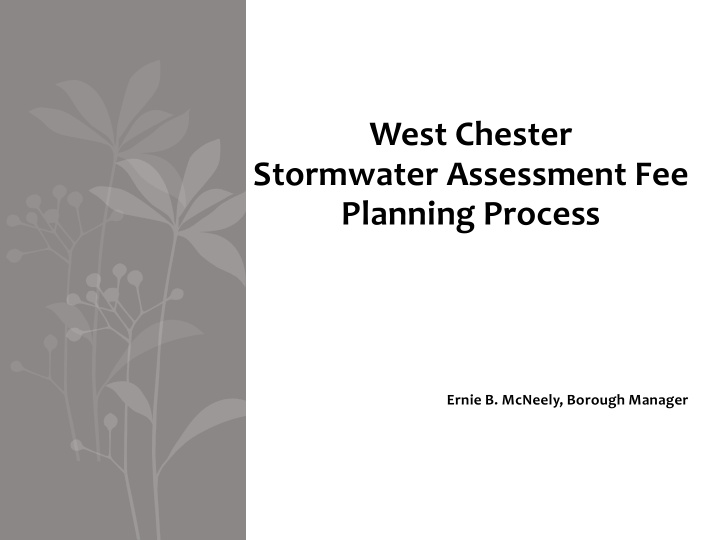



West Chester Stormwater Assessment Fee Planning Process Ernie B. McNeely, Borough Manager
Who we are? West Chester Borough – celebrated a bicentennial in 1999. Population 18,461 according to the 2010 Census – that counts about 3500 West Chester University students in on campus dorms but misses about 4000 students living in off-campus apartments. Host to West Chester University, Chester County Hospital (partial) and the county seat for Chester County – 34% tax exempt. West Chester University 14,000 students part of State System of Higher Education. Out of over 6700 housing units - 63% are rental. The Borough is 1.8 sq. miles so density of over 10,000 persons per square mile and mostly fully developed so very little room for new development unless it is redevelopment – not growing new tax base. Home Rule community since 1994.
How we began? West Chester participates as a member in the National League of Cities (NLC), Pennsylvania Municipal League (PML) & the International City-County Management Association (ICMA). Through those organizations we learned about stormwater utilities in other states funding stormwater needs. Began discussing the possibility in West Chester as early as 2009. Citizens Financial Advisory Committee in 2011 was made aware of the device and in their report recommended Council consider the stormwater fee as a means of financing existing and needed stormwater services. It became increasingly evident with MS4 permit requirements and TMDL standards issued for Goose Creek (part of Chester Creek) that regulatory requirements for stormwater management were becoming ever more stringent and costly. Several stormsewer collapses combined with an aggressive effort to televise existing stormsewers (old brick storms) produced evidence that we needed to do far more infrastructure repair and replacement than we had been doing or what the budget could finance.
How we began….continued Began watching the stormwater assessment adoption process in Philadelphia, Mt. Lebanon Twp., Meadville City and Radnor Twp. We realized that funding stormwater activities, growing regulatory requirements and long overdue capital infrastructure renewal needs with large real estate tax increases would be patently unfair since only 66% of our property pays real estate tax, the real estate tax burden bears no relationship to ability to pay and heavily impacts those on fixed incomes. A stormwater fee is designed to be fair and reflect (using impervious surface) the amount of stormwater a property is contributing to the stormwater that must be managed. Verified legal right to enact a stormwater assessment fee as a Home Rule community.
The Process - Consultant Proposals submitted February 6, 2013 Purpose of the feasibility study is to review West Chester Borough’s existing storm water management program, to make recommendations for future directions and changes, and to assess the feasibility of funding the program with a storm water assessment / utility user fee. What is the Borough currently doing in terms of storm water management? What are the storm water related problems, issues, needs, resources, and opportunities currently faced by the Borough? What storm water program priorities including new regulatory requirements should guide the Borough in the next five to ten years? What specific program improvements should be made and what will be the costs? What is (are) the best way(s) to pay for these program improvements? How should the funding method(s) be implemented?
The Process…..continued Stakeholder and public participation in the feasibility study required. Basic elements of a storm water management program, which must be addressed by the Program Development Task, include both operational and financial functions. Operations and Maintenance Regulation and Enforcement Engineering and Planning Capital Construction Administration and Finance Regulatory Compliance Billing and Collections Identification of the steps required to implement a storm water assessment utility fee based on the plan prepared during the process. Consultants required to possess and clearly identify their experience with guiding other municipalities through the design and implementation process for development of a storm water management assessment fee/utility. Consultants provide phased approach with pricing for each phase of the development process. Authorization required to proceed from each phase to the next. Project to take from 9 months to a year to complete.
RFP Results Firm Total Project Raftelis Financial Consultants Inc. $140,000 Meliora Design LLC./Brandywine Conservancy/ $ 97,800 Municipal & Financial Services Group CH2M Hill Inc. $204,710 AMEC Environ. & Infrastructure Inc./Gilmore Assoc. $214,729 Contract was awarded to CH2M Hill Inc. in March 2013.
The Experience An advisory committee was formed including stakeholders representing residents, business, West Chester University, Chester County Hospital, Chester County Government, churches, Borough Council, Borough staff and rental property owners. Three Advisory Committee Meetings each 3 hours in length have been held to date. Much time is spent initially bringing an Advisory Committee up to speed on the language of stormwater; ie. NPDES, MS4 Permits, impervious coverage, retention/detention systems and the interplay of regulatory bodies. The task of identifying past and current stormwater services and capital investment is fairly straightforward while settling on needed future services and capital needs is more subjective and open for disagreement.
The Experience….. continued Identifying a service level to fund with the stormwater assessment fee becomes even more difficult once service levels have been translated into proposed rates. Discussions on rate setting tend to gravitate to how to create a rate schedule that is both fair and not too complex to administer along with how to keep the rate as low as possible. One more advisory committee meeting is scheduled before a public presentation to Borough Council will be held. Unable to predict the outcome of either the Advisory Committee decisions or the eventual Borough Council action on the recommendations.
Recommend
More recommend